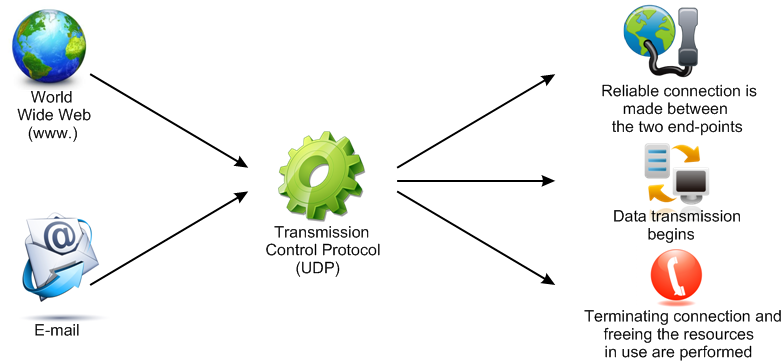VoIP TCP vs VOIP UDP
Data transmission is basically directed by TCP and UDP, one of them providing reliablity and the other providing speed. This article will explain which one and why that one is preferred by VoIP (Voice over Internet Protocol, which directs transmission of voice over the Internet) services. So if you need to know which VoIP service is better, then I suggest that you should read along this page and even watch the video if you wish.
Transmission Control Protocol (TCP) is one of the key protocols of the TCP/IP protocol family. It complements IP and that is why we usually mention them together. TCP defines the order of data transmission. Most services on the Internet, like the World Wide Web and e-mail, can be accessed via TCP (as Figure 1 shows it). When avoiding minor delays is more important than avoiding loss of data packets, UDP (User Datagram Protocol) is used.
How it works:
It is a connection-oriented protocol in transmission. Its main duty is to build up and maintain a reliable and safe connection between two processes. The process has basically three phases as seen in Figure 1:
- Reliable connection is made between the two end-points.
- Data transmission begins.
- Terminating connection and freeing the resources in use are performed.
On the left side of Figure 1 you can see where TCP is mainly used, that is on the World Wide Web, and in sending e-mails, while the left side shows how data are transmitted on the Web and via e-mail, as it was explained above.

User Datagram Protocol (UDP) is one of the basic protocols of the Internet. Its main duty is to provide service based on sending short and rapid messages. They are mainly used when speed counts more than reliability, since UDP does not guarantee the package to arrive at the destination. DNS, network games and real-time multimedia transmissions use it.
Why UDP is used for transport in VoIP:
So in TCP/IP, Internet Protocol (IP) routes packets, while TCP keeps it reliable, so if the packets are received too fast by the destination device, it slows down the transmission, so packets will arrive in the original order, and if a packet had an error, this TCP would retransmit it.
However, speech must arrive fast at the destination, so those applications, which do not need reliability as much as speed (like VoIP and teleconferencing), use UDP.
In VoIP, audio data are compressed into data packets before transmission via the Internet. These packets usually mean 10 to 30 milliseconds of sound. So, with TCP it would mean that 30 milliseconds of voice is sent, then received, then an acknowledgement packet would be sent back from the receiver, and as soon as the sender gets the acknowledgement packet, it would send the next 30 milliseconds. It would mean wasting a lot of time.
The lack of arrival of an acknowledgement packet on the sender side would make it resend the original data packet. So, this process makes this method rather accurate than efficient.
With UDP, however, data packets can be sent without acknowledgement, or without any response from the other side. Its disadvantage is that it has no error control, so data packets can arrive in a mixed order or it might happen that some of them do not arrive at all. For UDP mostly speed matters, and that is what makes it a perfect choice for VoIP.
So, if VoIP uses TCP then delays can be expected every time an error or a packet loss occurs, which would be quite annoying at the receiver's end. So, as reliability is not a requirement at a VoIP service, UDP is used. The packet losses sometimes do cause worse audio quality, but as it only means like 30 milliseconds of silence, it is still more acceptable for a user than several seconds of delay. So UDP provides a lot more reliable VoIP service than TCP would.
If you have already learnt that Ozeki Phone System always chooses the best solutions, and I think you have, then you must have guessed that it chooses VOIP UDP for your reliability and comfort. For Ozeki Phone System, the satisfaction of the user is the most important priority, so there is no need to be worried about your data arriving at destination in time and in order, since our professionals are experts at picking the right choices for you.
Check out the following articles for more information:
- What is voip?
- Voip calling explained
- VOIP Monitoring explained
- What is VoIP Client?
- What is VoIP Phone?
- What is VoIP cluster?
For a better understanding, please watch our video:
VoIP UDP vs. VoIP TCP (Video tutorial)
